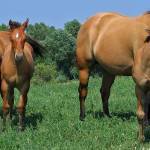Skeletal Issues in Older Foals: Angular Limb Deformities

With their long, gangly legs, foals often appear out of proportion, even a bit crooked-legged, during their first few weeks or months of life. Experts agree* that most foals are not born with perfectly straight limbs. If a foal does have limb deviation, at what point does an owner need to consider a veterinary evaluation?
“By definition, an angular limb deformity is a deviation of the limb in the sagittal plane. This means that if you are facing the foal, the limb deviates sideways, either inward or outward,” shared Laura Petroski, B.V.M.S., a veterinarian with Kentucky Equine Research.
For example, if the foal is facing you and the limb veers laterally or away from the midline, the deformity is referred to as a “carpal valgus.” This is the most familiar limb deviation in foals. On the other hand, a limb that is turned inward is considered to be “carpal varus.”
The most likely causes of angular limb deformity include factors that lead to weak soft-tissue support of a joint, such as premature birth; failure of the small cuboidal bones in the knee and hock to properly ossify; inflammation or infection of a growth plate; and nutritional imbalances or trauma to the growth plates leading to either excessive or retarded growth on one side.
According to the latest review articles on the topic*, the limbs of foals should be fully examined every two weeks. The natural bend in the limbs should improve with age, and no new deviations should develop. If your foal is not improving or is worsening, intervention should be considered.
“Angular limb deformities aren’t considered emergencies; however, time is of the essence. A foal’s growth plates begin to close as early as four months of age, depending on the joint. Once the growth plate is closed, long bone growth will no longer occur, and correction of the deformity will no longer be possible,” warned Petroski. “Therefore, it is important to work with a knowledgeable veterinarian as soon as a limb deviation is noted.”
Treatment options vary depending on the age of the foal, the location and underlying cause of the defect, and the severity of the lesions. Treatment could be as simple as corrective shoeing, modifications in exercise, and dietary changes, while other foals require surgical correction. In terms of surgery, procedures to either slow growth on one side of the limb to help the other side catch up or speed growth on the short side of the limb can be considered. Your veterinarian and farrier serve as excellent resources when making treatment decisions.
Just like other developmental orthopedic diseases, like osteochondrosis, nutrition plays an important role in the development and correction of angular limb deformities.
“Excess intake of energy may contribute to the development of angular limb deformities. Not all foals require creep feeding, which is a common source of excessive calories in young foals,” Petroski noted.
She added, “For detailed advice on how best to feed your foal and whether creep feeding is necessary, contact a Kentucky Equine Research nutrition advisor. In addition, consider offering foals Triacton, a triple-action nutrition supplement that supports skeletal tissues and protects the stomach against gastric ulcers, another common ailment affecting young stock.”
*García-López, J.M. 2017. Angular limb deformities: Growth augmentation. Veterinary Clinics of North America: Equine Practice 33(2):343-351.
*McCarrel, T.M. 2017. Angular limb deformities: Growth retardation. Veterinary Clinics of North America: Equine Practice 33(2):353-366.








